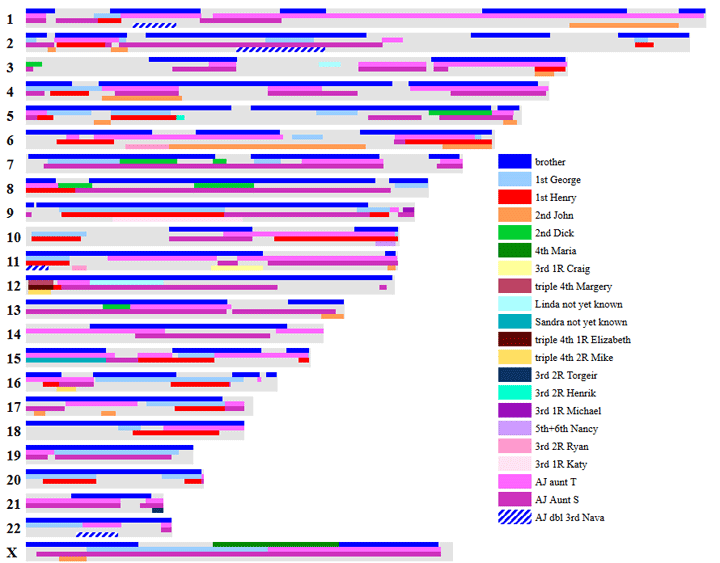How do you use autosomal DNA testing to enhance your genealogical research without having to take a PhD level course? This is a question several of my cousins have asked me, so here is my attempt to answer.
- First of all, get as many relatives to test as you can. The more data you have, the easier it is to make useful comparisons and sort new DNA relatives into their related family lines. The closer family members shown in my chromosome map above are all cousins I convinced to test.
- Secondly, make sure you know how to use a spreadsheet: sorting, deleting rows, inserting columns; you only need to know the easy stuff. [UPDATE: click here for my post with a youtube video teaching that easy spreadsheet stuff]
- Third, check your understanding of how DNA works. Perhaps read my basics page – http://blog.kittycooper.com/2013/04/the-basics-at-23andme/ – and follow up with whichever lessons, books or videos appeal to you among those that I suggest or that you find listed in the ISOGG wiki – http://www.isogg.org/wiki/Autosomal_DNA
Also lots of beginner questions are answered in the FAQ I keep for the DNA-NEWBIES mailing list on yahoo; a copy is on this blog – http://blog.kittycooper.com/dna-testing/newbie-faq/ – so check there when something is confusing. - Fourth, bookmark a page with an explanation of all the acronyms – this is a good one: http://www.isogg.org/wiki/Abbreviations – a key term is cM. You do not need to understand the definition of a centimorgan (cM), hardly anyone does; just accept that it is the best measure of the importance of a DNA match, the larger the better.
Now to the practical application of all this, using shared DNA segment data to find relatives, preferably those 3rd and 4th cousins that your family no longer knows of. Click on success stories on this blog to read about some of the cousins I have found with DNA.
When people are shown as matches to you or your relatives, the testing company will make a guess as to how closely related they are. Beyond 3rd cousins, it is not possible for them to make an accurate estimate because of the random nature of DNA inheritance.
